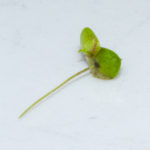Lemna minor
USDA, NRCS. 2018. The PLANTS Database (http://plants.usda.gov, 28 March 2018). National Plant Data Team, Greensboro, NC 27401-4901 USA.
Illustration courtesy of University of Florida/IFAS Center for Aquatic and Invasive Plants. Used with permission.
What is Common Duckweed?
Physical Characteristics
Leaves:
- 1-3 leaves
- 1/16 to 1/8 inches long
- Light-green
- Nearly flat on both sides
- Flat, oval shape
Fruit:
- Small, bladder-like shape
- Slightly winged
Seeds:
- Long rigid seed or smooth with spongy outer layer
Roots:
- Single root
- Cluster together with other duckweed in groups of 2 to 5+
Where Does it Grow?
EDDMapS. 2024. Early Detection & Distribution Mapping System. The University of Georgia – Center for Invasive Species and Ecosystem Health. Available online at http://www.eddmaps.org/; last accessed January 17, 2024.
Duckweeds tend to grow in dense colonies in quiet water, undisturbed by wave action. Often more than one species of duckweed will be associated together in these colonies.
Is it Invasive?
Although Duckweed is native, it can be aggressive invaders of ponds and are often found mixed in with mosquito fern or watermeal. If colonies cover the surface of the water, then oxygen depletion and fish kills can occur. These plants should be controlled before they cover the entire surface of the pond.
Pros and Cons of Common Duckweed
Many kinds of ducks consume duckweed and often transport it to other bodies of water. Duckweed colonies provide habitats for micro invertebrates, but if duckweed completely covers the surface of a pond for an extended period of time, it will cause oxygen depletion. These colonies will also eliminate submerged plants by blocking sunlight penetration.




